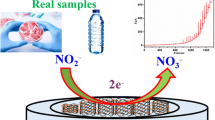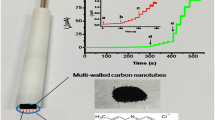Abstract
The paper describes an electrochemical nitrite sensor based on the use of a nanocomposite consisting of poly(3,4-ethylenedioxythiophene) (PEDOT) doped with polyacenic semiconductor (PAS), a quasi-graphene carbon material. The composite possesses a large specific surface area and a large number of active sites. It shows high catalytic activity towards the oxidation of nitrite. Such activity is not observed in the individual components. Nitrite provides a well-defined oxidation peak at 0.80 V (vs. Ag/AgCl) at a pH value of 7.4. The influence of many possible ionic interferents was found to be negligible. In addition, the oxidation peaks of dopamine hydrochloride, ascorbic acid, uric acid and nitrite are well separated from each other. Under optimized experimental conditions, anodic peak currents are linearly related to nitrite concentrations in the range from 0.3 μM to 6.6 mM, and the detection limit is 98 nM (at an S/N ratio of 3). The sensor was used to quantify nitrite in (spiked) tap water and sausage samples, where it gave acceptable recoveries.

Schematic presentation of a nanocomposite consisting of poly(3,4-ethylenedioxythiophene) (PEDOT) doped with polyacenic semiconductor (PAS). The composite possesses a large specific surface area and a large number of active sites. It shows high catalytic activity towards the oxidation of nitrite.





Similar content being viewed by others
References
Filik H, Giray D, Ceylan B, Apak R (2011) A novel fiber optic spectrophotometric determination of nitrite using safranin O and cloud point extraction. Talanta 85:1818–1824
Wang X, Adams E, Van Schepdael A (2012) A fast and sensitive method for the determination of nitrite in human plasma by capillary electrophoresis with fluorescence detection. Talanta 97:142–144
Feng S, Zhang M, Huang Y, Yuan D, Zhu Y (2013) Simultaneous determination of nanomolar nitrite and nitrate in seawater using reverse flow injection analysis coupled with a long path length liquid waveguide capillary cell. Talanta 117:456–462
Wang X, Fan J, Ren R, Jin Q, Wang J (2016) Rapid determination of nitrite in foods in acidic conditions by high-performance liquid chromatography with fluorescence detection. J Sep Sci 39:2263–2269
Haldorai Y, Kim JY, Vilian ATE, Heo NS, Huh YS (2016) An enzyme-free electrochemical sensor based on reduced graphene oxide/Co3O4 nanospindle composite for sensitive detection of nitrite. Sensors Actuators B Chem 227:92–99
Wang J, Xu G, Wang W, Xu S, Luo X (2015) Nitrite oxidation with copper–cobalt nanoparticles on carbon nanotubes doped conducting polymer PEDOT composite. Chem Asian J 10:1892–1897
Wang H, Chen P, Wen F, Zhu Y, Zhang Y (2015) Flower-like Fe2O3@ MoS2 nanocomposite decorated glassy carbon electrode for the determination of nitrite. Sensors Actuators B Chem 220:749–754
Meng Z, Zheng J, Li Q (2015) A nitrite electrochemical sensor based on electrodeposition of zirconium dioxide nanoparticles on carbon nanotubes modified electrode. J Iran Chem Soc 12:1053–1060
Marlinda AR, Pandikumar A, Yusoff N, Huang NM, Lim HN (2015) Electrochemical sensing of nitrite using a glassy carbon electrode modified with reduced functionalized graphene oxide decorated with flower-like zinc oxide. Microchim Acta 182:1113–1122
Mehmeti E, Stanković DM, Hajrizi A, Kalchera K (2016) The use of graphene nanoribbons as efficient electrochemical sensing material for nitrite determination. Talanta 159:34–39
Cosnier S, Holzinger M (2011) Electrosynthesized polymers for biosensing. Chem Soc Rev 40:2146–2156
Shi Y, Peng L, Ding Y, Zhao Y, Yu G (2015) Nanostructured conductive polymers for advanced energy storage. Chem Soc Rev 44:6684–6696
Hatchett DW, Josowicz M (2008) Composites of intrinsically conducting polymers as sensing nanomaterials. Chem Rev 108:746–769
Matsui T, Inose Y, Powell DA, Shadrivov LV (2016) Electroactive tuning of double-layered metamaterials based on π-conjugated polymer actuators. Adv Opt Mater 4:135–140
Günes S, Neugebauer H, Sariciftci NS (2007) Conjugated polymer-based organic solar cells. Chem Rev 107:1324–1338
Scott JC, Bozano LD (2007) Nonvolatile memory elements based on organic materials. Adv Mater 19:1452–1463
Kim SH, Bae TS, Heo W, Joo T, Song KD, Park HG, Ryu SY (2015) Effects of gold-nanoparticle surface and vertical coverage by conducting polymer between indium tin oxide and the hole transport layer on organic light-emitting diodes. ACS Appl Mater Interfaces 7:15031–15041
Roh E, Hwang BU, Kim D, Kim BY, Lee NE (2015) Stretchable, transparent, ultrasensitive, and patchable strain sensor for human–machine interfaces comprising a Nanohybrid of carbon nanotubes and conductive elastomers. ACS Nano 9:6252–6261
Inal S, Malliaras GG, Rivnay J (2016) Optical study of electrochromic moving fronts for the investigation of ion transport in conducting polymers. J Mater Chem C 4:3942–3947
Deetuam C, Samthong C, Thongyai S, Praserthdam P, Somwangthanaroj A (2014) Synthesis of well dispersed graphene in conjugated poly (3, 4-ethylenedioxythiophene): polystyrene sulfonate via click chemistry. Compos Sci Technol 93:1–8
Castagnola V, Descamps E, Lecestre A, Dahan L, Remaud J, Nowak LG, Bergaud C (2015) Parylene-based flexible neural probes with PEDOT coated surface for brain stimulation and recording. Biosens Bioelectron 67:450–457
Hui N, Wang W, Xu G, Luo X (2015) Graphene oxide doped poly (3, 4-ethylenedioxythiophene) modified with copper nanoparticles for high performance nonenzymatic sensing of glucose. J Mater Chem B 3:556–561
Vreeland RF, Atcherley CW, Russell WS, Xie JY, Lu D, Laude ND, Porreca F, Heien ML (2015) Biocompatible PEDOT: Nafion composite electrode coatings for selective detection of neurotransmitters in vivo. Anal Chem 87:2600–2607
Tolstopjatova EG, Eliseeva SN, Nizhegorodova AO, Kondratiev VV (2015) Electrochemical properties of composite electrodes, prepared by spontaneous deposition of manganese oxide into poly-3,4-ethylendioxythiophene. Electrochim Acta 173:40–49
Tepeli Y, Aslan S, Sezer E, Anik U (2015) Combination of a poly (3, 4-ethylene-dioxythiophene) electrode in the presence of sodium dodecyl sulfate with centri-voltammetry. Anal Methods 7:6740–6746
Wang W, Xu G, Cui XT, Sheng G, Luo X (2014) Enhanced catalytic and dopamine sensing properties of electrochemically reduced conducting polymer nanocomposite doped with pure graphene oxide. Biosens Bioelectron 58:153–156
Zanardi C, Terzi F, Pigani L, Heras A, Colina A, Lopez-Palacios J, Seeber R (2008) Development and characterisation of a novel composite electrode material consisting of poly (3, 4-ethylenedioxythiophene) including au nanoparticles. Electrochim Acta 53:3916–3923
Yamabe T, Fujii M, Mori S, Kinoshita H, Yata S (2004) The structural analysis of various hydro-graphene species. Synth Met 145:31–36
Liu J, Zhang X, Wang R, Zhang J (2012) Facile synthesis of LiFePO4 nanoparticles coated by few layers of PAS with quasi-graphene structure. Int J Electrochem Sci 7:12983–12991
Wang C, Lin L, Lu N, Zhao Q, Sun L, Zhao S, Wang R (2008) Preparation and structure of porous carbons by pyrolysis of phenol formaldehyde resin. Acta Chim Sin 66:1909–1914
Wang J, Zhou H, Fan D, Zhao D, Xu C (2015) A glassy carbon electrode modified with nanoporous PdFe alloy for highly sensitive continuous determination of nitrite. Microchim Acta 182:1055–1061
Rabti A, Aoun SB, Raouafi N (2016) A sensitive nitrite sensor using an electrode consisting of reduced graphene oxide functionalized with ferrocene. Microchim Acta 183:3111–3117
Zhuang Z, Lin H, Zhang X, Qiu F, Yang H (2016) A glassy carbon electrode modified with carbon dots and gold nanoparticles for enhanced electrocatalytic oxidation and detection of nitrite. Microchim Acta 183:2807–2814
Dai J, Deng D, Yuan Y, Zhang J, Deng F, He S (2016) Amperometric nitrite sensor based on a glassy carbon electrode modified with multi-walled carbon nanotubes and poly(toluidine blue). Microchim Acta 183:1553–1561
Acknowledgments
This work was supported by the Natural Science Foundation of China (U1303283), National High Technology Research and Development Program of China (2015AA034602), China Postdoctoral Science Foundation (2015 M582738), The Science and Technology Project and Achievement Transformation Plan of Modern Agriculture of Xinjiang Corps (2016 AC010), Key Laboratory of Prevention and Control of Animal Disease of Xinjiang Corps (BTDJ05), Key research and development project of Shandong Province (2016GGB01989) and The High-end Foreign Experts Recruitment Program of China (GDJ20143700012).
Author information
Authors and Affiliations
Corresponding authors
Ethics declarations
The author(s) declare that they have no competing interests.
Electronic Supplementary Material
ESM 1
(PDF 759 kb)
Rights and permissions
About this article
Cite this article
Chen, L., Liu, X., Wang, C. et al. Amperometric nitrite sensor based on a glassy carbon electrode modified with electrodeposited poly(3,4-ethylenedioxythiophene) doped with a polyacenic semiconductor. Microchim Acta 184, 2073–2079 (2017). https://doi.org/10.1007/s00604-017-2189-0
Received:
Accepted:
Published:
Issue Date:
DOI: https://doi.org/10.1007/s00604-017-2189-0




